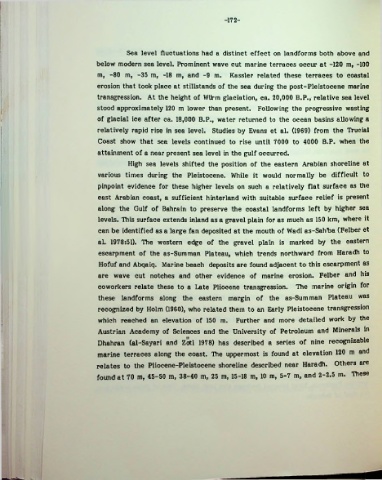Page 196 - Life & Land Use on the Bahrain Islands (Curtis E Larsen)
P. 196
-172-
Sea level fluctuations had a distinct effect on landforms both above and
below modern sea level. Prominent wave cut marine terraces occur at -120 m, -100
m, -80 m, -35 m, -18 m, and -9 m. Kassler related these terraces to coastal
erosion that took place at stillstands of the sea during the post-Pleistocene marine
transgression. At the height of WIVm glaciation, ca. 20,000 B.P., relative sea level
stood approximately 120 m lower than present. Following the progressive wasting
I
of glacial ice after ca. 18,000 B.P., water returned to the ocean basins allowing a
relatively rapid rise in sea level. Studies by Evans et al. (1969) from the Trucial
Coast show that sea levels continued to rise until 7000 to 4000 B.P. when the
attainment of a near present sea level in the gulf occurred.
High sea levels shifted the position of the eastern Arabian shoreline at
various times during the Pleistocene. While it would normally be difficult to
pinpoint evidence for these higher levels on such a relatively flat surface as the
east Arabian coast, a sufficient hinterland with suitable surface relief is present
along the Gulf of Bahrain to preserve the coastal landforms left by higher sea
levels. TTiis surface extends inland as a gravel plain for as much as 150 km, where it
can be identified as a large fan deposited at the mouth of Wadi as-Sah^a (Felber et
al. 1978:51). The western edge of the gravel plain is marked by the eastern
escarpment of the as-Summan Plateau, which trends northward from Haradh to
Hofuf and Abqaiq. Marine beach deposits are found adjacent to this escarpment as
are wave cut notches and other evidence of marine erosion. Felber and his
coworkers relate these to a Late Pliocene transgression. Tlie marine origin for
these landforms along the eastern margin of the as-Summan Plateau was
recognized by Holm (1960), who related them to an Early Pleistocene transgression
which reached an elevation of 150 m. Further and more detailed work by the
Austrian Academy of Sciences and the University of Petroleum and Minerals in
Dhahran (al-Sayari and Zotl 1978) has described a series of nine recognizable
marine terraces along the coast. The uppermost is found at elevation 120 m and
Others are
relates to the Pliocene-Pleistocene shoreline described near Haradh.
TTiese
found at 70 m, 45-50 m, 38-40 m, 25 m, 15-18 m, 10 m, 5-7 m, and 2-2.5 m.

